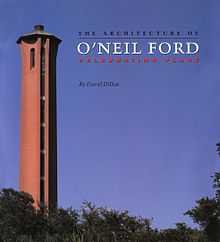O'Neil Ford
| O'Neil Ford | |
|---|---|
 | |
| Born |
December 3, 1905 Pink Hill, Texas |
| Died |
July 20, 1982 (aged 76) San Antonio, Texas |
| Nationality | American |
| Awards | Fellow of the American Institute of Architects, appointed to the National Council on the Arts, National Historical Landmark |
| Buildings | Tower of the Americas, Little Chapel in the Woods, Emily Fowler Public Library, The Selwyn School,First Christian Church, Denton |
| Projects | La Villita, Skidmore College, Trinity University, University of Texas at San Antonio |
O'Neil Ford (December 3, 1905 – July 20, 1982) was an American architect of the mid-20th century in Texas and a leading architect of the American Southwest. He is considered one of the nation's best unknown architects, and his designs merged the modernism of Europe with the indigenous qualities of early Texas architecture.[1]
Biography
O'Neil Ford was born in Pink Hill, Texas in 1905. He moved to Denton, Texas in 1917 after the death of his father. He enrolled in North Texas State Teachers College for two years, but financial burdens forced him to abandon his efforts of a formal education. Instead, he earned an architectural certificate by mail from the International Correspondence Schools of Scranton, Pennsylvania.
In 1926, he began a long partnership with regional architects and was first mentored by architect David R. Williams. Together they produced a number of fine regional houses of native brick, wood, and stone in north central Texas. He entered into private practice in 1934 and worked with a series of partners within the state of Texas beginning in 1936.[1]
Ford was influenced by the tradition of the English Arts and Crafts Movement and the attempt to combine architecture and visual arts. As a strong preservationist, he helped launch Texas architecture on a new path by showing that its roots were deep and often beautiful.[2] His well-crafted structures were composed of bricks, glass, wood, and were intimately tied to its setting. He enlisted his brother Lynn, a master carver and sculptor, to create custom doors, screens, and louvered grates.[3]
Ford was elected a Fellow of the American Institute of Architects in 1960. He was appointed to the National Council on the Arts by President Lyndon B. Johnson, and in 1974 Ford himself was designated a National Historic Landmark by the Council (the only human to ever be given that title).[4] In 1967, he was elected into the National Academy of Design as an Associate Academician.
He resided in San Antonio until his death in 1982 at age 76. In 2001 Drawings were donated by his widow, Wanda Graham Ford, to the Alexander Architectural Archive at the University of Texas at Austin. The gift included 5,540 original architectural drawings, 5,484 prints, 40 presentation drawings, 39 presentation sketches, and 63 sheets of photographic materials.[5]
Significant Work
Ford designed several buildings in Denton, among them the Little Chapel in the Woods, renovations at the Emily Fowler Public Library, the Denton Civic Center, Denton's City Hall and several buildings at The Selwyn School. Because his designs form much of Denton's identity, a Texas historical marker honoring Ford was dedicated at the Emily Fowler Library in 2009.[6]
Later based in San Antonio, many of Ford's works are found in that city. They include the renovation of La Villita, the campus of Trinity University, the campus of Saint Mary's Hall, the University of Texas at San Antonio Main Campus, and the Tower of the Americas.
Other significant works include buildings at Skidmore College and several facilities around the world designed for Texas Instruments. Shortly before his death, he completed the design of the building of the Museum of Western Art in Kerrville in the Texas Hill Country.
References
- ↑ 1.0 1.1 "O'Neil Ford - Great Buildings Online". Greatbuildings.com. Retrieved 2013-09-03.
- ↑ "Table of Contents and Excerpt, Dillon, The Architecture of O'Neil Ford". Utexas.edu. Retrieved 2013-09-03.
- ↑ "Architecture + Morality: O'Neil Ford: The Search for an Authentic Modern Response". Architectureandmorality.blogspot.com. 2009-01-20. Retrieved 2013-09-03.
- ↑
- ↑
- ↑ "State Marker Honors O'Neil Ford." The Denton Record Chronicle. March 11, 2009.
- Dillon, David (1992). The Architecture of O'Neil Ford: Celebrating Place. Austin, Texas: University of Texas Press. ISBN 0-292-71602-8.
- Dallas Architecture Blog, Architect O’Neil Ford Designed His First Modern Home in Turtle Creek Park
External links
- O’Neil Ford - “Designing Denton and Beyond”
- A Catalogue of the Works of O'Neil Ford in Denton, Texas
- Photos of 11535 Hillcrest Road
- Best Examples of Architect O’Neil Ford’s Texas Modern Designed Homes
- Interview with O’Neil Ford, August 5, 1976. University of Texas at San Antonio: Institute of Texan Cultures: Oral History Collection, UA 15.01, University of Texas at San Antonio Libraries Special Collections.
|